Posts filed under ‘product design’
Cycling Social Innovation Part 3: Zanzibar
 Picture 1: Water delivery [CM]
Picture 1: Water delivery [CM]
Continuing with the series of posts about equality fostered by bicycles [Check out the part 1 post: Cycling in Morocco and Part 2: Cycling in Cuba, I wanted to add some other ethno-photographs regarding a series of “usage innovations or self-crafted adaptations” that are, in this case, portraying the island of Zanzibar, Tanzania. Check out the rationale for this series in the previous posts. [All pictures taken by CM ]


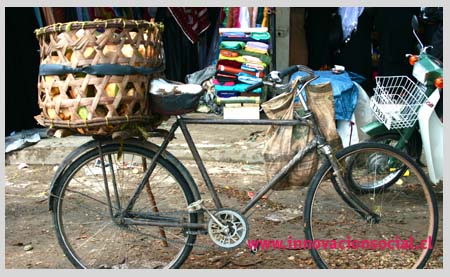 Baskets made from palm trees serve to carry and exhibit groceries (more…)
Baskets made from palm trees serve to carry and exhibit groceries (more…)
Cycling Social Innovation Part 2: Cuba
 Continuing with the series of posts about equality fostered by bicycles [Check out the part 1 post: Cycling in Morocco], I wanted to add some other ethno-photographs regarding a series of “usage innovations or self-crafted adaptations” that are, in this case, portraying Cubans [Taken on a “road trip” from Havana to Santiago de Cuba and the Keys]. And Cuba affords a not very common setting. Not only for it’s political standing, but because there are constraints that oblige people to make what they can form the things they have available on the island. A huge contrast with the excessive use planned obsolescence of industrial designs present in countries like the States, France or Spain. Nonetheless, the “commuting” context in Cuba is not easy. Roads are full of holes, individuals wait for hours for any transportation for getting from one place to another which can make a day-to-day journey harder than what we are used to. Yet, innovation driven by scarcity does happen in this context… and you can even get a hole in your tire fixed with a “condom” [no kidding], which thanks to the State birth control policies, are cheaper to get than a rubber repair kit for your bike. In the end it’s still a polymer no? Still, patterns arise when comparing the cycling behaviors of Cubans, Chileans, West Africans and even in the States…. They will be visible as other posts are revealed. [All pictures taken by CM ]
Continuing with the series of posts about equality fostered by bicycles [Check out the part 1 post: Cycling in Morocco], I wanted to add some other ethno-photographs regarding a series of “usage innovations or self-crafted adaptations” that are, in this case, portraying Cubans [Taken on a “road trip” from Havana to Santiago de Cuba and the Keys]. And Cuba affords a not very common setting. Not only for it’s political standing, but because there are constraints that oblige people to make what they can form the things they have available on the island. A huge contrast with the excessive use planned obsolescence of industrial designs present in countries like the States, France or Spain. Nonetheless, the “commuting” context in Cuba is not easy. Roads are full of holes, individuals wait for hours for any transportation for getting from one place to another which can make a day-to-day journey harder than what we are used to. Yet, innovation driven by scarcity does happen in this context… and you can even get a hole in your tire fixed with a “condom” [no kidding], which thanks to the State birth control policies, are cheaper to get than a rubber repair kit for your bike. In the end it’s still a polymer no? Still, patterns arise when comparing the cycling behaviors of Cubans, Chileans, West Africans and even in the States…. They will be visible as other posts are revealed. [All pictures taken by CM ] 
Commuting is not really easy…. 
Portioning to make products affordable for the BOP
 Picture: Kiosk in Cape Coast Ghana [CM]
Picture: Kiosk in Cape Coast Ghana [CM]
Affordability of consumer products is not just an issue of “marketeability”, but of understanding that everyone has the right to be considered a “valuable consumer”, and that everyone should have access to them. It was in the frame of a joint venture with Unilever Chile and our Chilean design Studio: Design for Social Innovation, that this topic was raised by one of our students. It has also been a topic commented by some economists such as the deceased CK Prahalad.
Some consumers, such as manual laborers [in the case of South America and Africa] might not have “the cash” to access to large quantities of a certain product. In simple words, what I mean [for what I’ve observed and what I’ve taken from self-performed interviews] is that: some individuals get paid for a week of work [sometimes they do what in Chile we would call “pololos”, that being short-time period of a certain job] and usually that money, is spent weekly. Generally, there is no big salary at the end of the month [which is normally believed to be the standard], or there are not sufficient funds to get the “whole product” [the complete package] once a month. So the consuming behavior is driven by the needs derived of using weekly or daily the money in small quantities for immediate consumption. 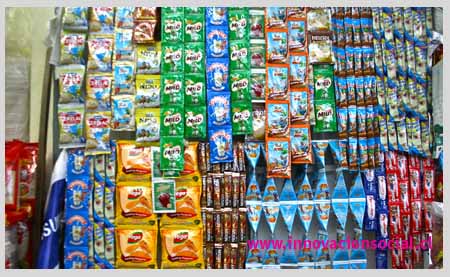 Picture: Kiosk in Cape Coast Ghana 2010 [CM]
Picture: Kiosk in Cape Coast Ghana 2010 [CM]
The other issue is, generally, supermarkets are usually not located near to the Bottom of the Pyramid [BOP] populations. So if they would want to get something, they have to spent money in Public Transportation [going and returning]. This could be a critical expense when you are thinking about low-weekly salaries.
For what we’ve seen, in countries like Chile, Perú, Bolivia, Argentina, Mali, Ghana, Brukina Faso, Kenya and others, (more…)
Global Mamas, re-using for change [Ghana]
 Photo: Mali, frontier with Burkina Faso [CMiranda]
Photo: Mali, frontier with Burkina Faso [CMiranda]  Pencil Case made of re-used water sachets [CM]
Pencil Case made of re-used water sachets [CM]
Not long ago, one of the professors at NC State, working in the Ghana abroad program had mentioned the existence of the organization: “Global Mamas”. I was pretty pleased, as I arrived in Accra, to verify the great work they are doing. One of the product lines that caught my attention were the recycled ones categorized under “trashy bags”. There is even a particular NGO just dedicated to this area. These women are not just manufacturing products with reused materials [remember there is a big difference between recycle and re-use. Re-using is even better than recycling as it requires no energy to turn mater into another form], but creating a whole selling experience out of it [not to speak about the benefits of small and successful entrepreneurship].
They reuse, mainly, plastic bags coming from the consumption of the lovely Fan Milk products [ice cream packaged in a cheap Polypropylene bag] and purified water sachets. Photo: Trash in drains, Cape Coast, Ghana [CMiranda]
Photo: Trash in drains, Cape Coast, Ghana [CMiranda]
Both of this Bottom of the Pyramid consuming products just cost a few cents [literally, water sachets cost less than 10]. Why getting a 1 dollar water bottle if (more…)
There is potential in using Design and “making physical models” in education
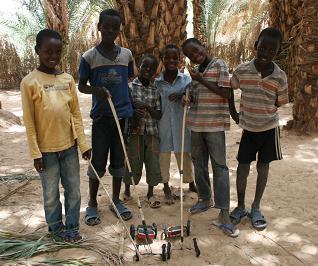 Photos: Mauritania, Oasis Legueila, (CMiranda)
Photos: Mauritania, Oasis Legueila, (CMiranda)
The concept of “Learning with design” is more popular than what normally people think. Nonetheless, this concept can be linked to the Understanding by Design methodology (Wiggins & McTighe, 1998). This methodology is really complex, and it involves themes and stances on curriculum planning, progress monitoring and knowledge assessment.
Considering that nobody reads a blog when it is too long, it seems interesting to us to share some “natural and innate” examples of kids and sophisticated “model making” found in Mauritania (Legueila is an oasis located in the region of “Atar” in Mauritania. There, families come to make their living out of the collection and selling of “dates“) and in Saint Louis, Senegal. These examples show how kids build and create “models” innately. In these cases, in the form of toys. Shortsighted, we can consider these toys as the “new toys for the ones that cannot access to them”. On the other hand, we can look at these toys with the potential to be models.
Models, as we’ve pointed before in the blog, are a mean to embody knowledge. They can help make complexity more manageable. These models, as these examples show, do not need to be sophisticated (as the candy models that some schools in the States use to teach biology in schools). They can work with anything you have at hand: a can, two (more…)
Entrepreneurial Design for Extreme Affordability- Stanford 2010
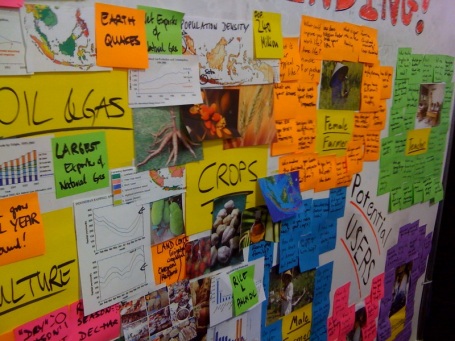 Picture: Pablo Fernandez
Picture: Pablo FernandezStanford is widely known because of Google, Sun Microsystems and other technologies breakthrough (like the new number one app for Ipad; Pulse). Amazing things who have made their inventors rich (and also Stanford; all the students have to sign an agreement where they agree to share part of their revenues).

Look to local solutions – Marrakech
Around three days ago, walking through the streets of the Medina (old city) in Marrakech (Morocco), we found these interesting artifacts designed and sold locally. One of the remarkable things about these objects, is that they are meant to be sold within the community (so it is a business which profit stays in the community itself).
Hints from this post
03.Do not confuse re-use (this case) and recycle
Ducha Móvil/ Baño
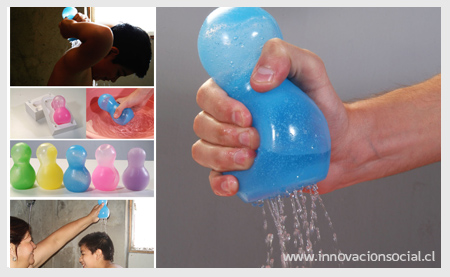
Ducha Móvil
Gonzalo Castro
Después de un acucioso estudio en terreno e involu¬crándose con las personas de campamentos y villas, el alumno se da cuenta de que un amplio porcentaje no ha adquirido un calefón. Las casas vienen con un baño digno, pero deben adquirir el sistema de calentamiento del agua por su cuenta. Son varias las razones que los llevan a no hacerlo: otras priorida¬des de compra, ahorro en un gasto fijo nuevo, falta de dinero para solventar la compra de uno, etc. Es por esta razón que incurren en el “lavado por par¬tes”: calientan agua, la transportan en un recipiente hacia el sector de ducha, la mezclan con agua fría y se mojan con un recipiente más pequeño. Esto les causa problemas posturales, cansancio y no les permite disfrutar del ducharse. Gonzalo crea una “ducha móvil” de silicona. Su forma le permite ser llenada por vaciado y ser manipulada con facilidad. La ubicación de los orificios en la base logra que el agua salga dando la sensación similar al de una ducha normal. El costo rodea los 300 pesos chilenos.
Organiza Despensa/ Cocina

Murciélago, organizador de despensa.
Constanza Herrera
Observó el desorden producido en las despensas al apilar distintos tipos de productos dentro de ella como envases con y sin base de apoyo, loza, etc. Todos los productos se acumulan en la parte baja de la repisa, quedando el espacio superior desocupado. La oportunidad de diseño es aprovechar los vacíos existentes para optimizar los espacios en la despensa y descongestionar el desorden existente. El producto es un organizador que permite elevar los productos sin base dentro la despensa. Está compuesto por un soporte alargado que se ajusta a las repisas de estos muebles y tres ganchos que se cuelgan uno tras otro a través de un riel en él, ellos cumplen la función de cerrar o sujetar los productos y levantarlos para distribuir equitativamente los productos en el espacio. Los ganchos pueden sacarse y ponerse en el soporte de forma independiente entre ellos, para llevar los productos al refrigerador u otro lugar donde se requiera.
Recarga Lavado/ Almacén
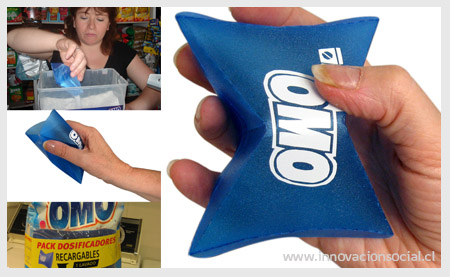
Recarga de lavado
Constanza Justiniano
La falta de acceso a servicios y productos hace que los consumidores de la base de la pirámide tengan que pagar más por los productos que requieren en el día a día. Sabiendo esto, Constanza estudia el comportamiento de compra en el barrio. Los almacenes concentran la demanda de compras inmediatas en pequeñas cantidades. Se vuelve a la venta a granel. Un mismo producto puede costar un 40% más por ser comprado parceladamente en un almacén en vez de ser comprado en un supermer¬cado con precios competitivos. Justiniano genera un sistema que consta de un envase plegable que permite comprar una o media recarga de detergente a un costo menor que si es que se comprara directa¬mente en el almacén. El envase cuesta 30 pesos chilenos.




